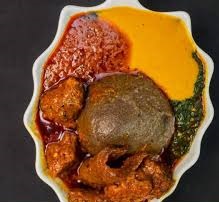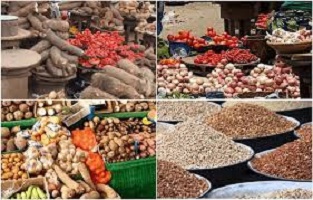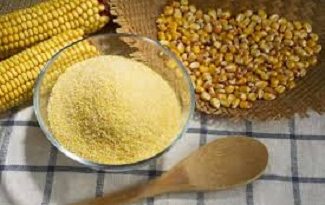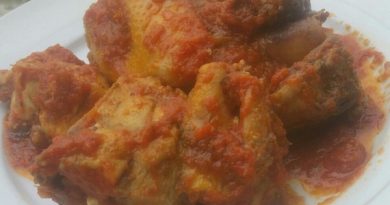Amala – How to Make Lump Free and Fluffy Amala Recipe
Amala is a traditional Nigerian native food to the Yoruba ethnic group in the western states of the country. It’s made out of unripe plantain flour, yam flour, and/or cassava flour.
Table of Contents
What is Amala Made of?
Yams are peeled, cut, washed, and dried before being ground into a flour known as èlùbo. Yams are white when fresh, but when dried, they turn brown. This is how àmàlà is made of and gets its color.

ÀMÀLÀ is a West African dish consumed mostly by the Yoruba people of Nigeria, particularly in the state of Oyo. Ibadan people do not play with amala and ewedu, likewise akpu na ofe onuigbu for an Ibo man
Related: Amala Food Recipe | Easy Nigerian Food | Health Benefits
In the southwest of Nigeria, indigenous people are the main consumers of amala food. A variety of obes (soups), such as f, ilá, ewéd, ogbono, or bar (black-eyed beans soup), could accompany it.
Types of Amala
- Àmàlà isu,
- Àmàlà láfn, and
- Amala ogede are the three types of àmàlà.
- Àmàlà Isu (Yam Flour)
This is the most common àmàlà fufu, and it is made from yam. Because of its high starch content, Dioscorea cayenensis is the ideal yam species for making àmàlà.
Yam grows throughout Africa, Asia, the Caribbean, Oceania, and Latin America, and is the common name for plants in the genus Dioscorea.
95 percent of it, however, is grown and harvested in West Africa.
Yam can be eaten in a variety of ways, including boiling, roasted, baked, fried, and ground into flour.
Because of the perishability of yam due to its high moisture content, it is necessary to dry it into less perishable goods such as yam flour.
The flour can be reconstituted with hot water to make a paste or gel known in Ghana as Kokonte and in Nigeria as “Amala.”
Dried yam is used to make amàlà isu. When added to boiling water, it turns a black/brownish color.
Because yam is a key source of carbohydrates for many people in the Sub-Saharan region, particularly in the yam zone of West Africa, hence, amala is high in carbs.
- Àmàlà láfn (cassava flour)
The àmàlà láfn, which is manufactured from cassava flour, is the second type. “Lafun” is the name given to dried cassava flour in Nigeria and “kokanee” in Ghana
Cassava is a Euphorbiaceae (spurge) family woody shrub. The most prominent carbohydrate sources in Nigeria are cassava and yam.
Nigeria is the world’s leading cassava producer. Àmàlà láfn is made from cassava flour as a dry powder.
Garri, a fermented and flaky meal popular among the Ijebu people, is another common meal from cassava.
- Plantain flour (Amala ogee)
Elubo ogede is another form of Amala (which is usually lighter in color). Plantain flour’s low carbohydrate content makes it an ideal diet for diabetics and those who require a low-carbohydrate diet.
Unripe plantains are peeled, dried, and grated into boiling water to make amala ogee, which is light brown.
Amala Recipe – How to Make Amala
The only ingredients needed to make àmàlà fufu are boiling water and one of the desired types of flour.
This recipe is for black Amala the white one (Lafun) is made differently. So below is a step-by-step guide to making Amala perfect.
Method
- Firstly, the heat is turned down after the water has reached a boil.
- Then, the flour is added and mixed until the water has been absorbed completely.
- After that, more hot water is added, then the dough is left to simmer for approximately five minutes.
- Lastly, the dough is then kneaded until it is smooth and fluffy.
The most challenging element of creating àmàlà is kneading the dough into a smooth paste without lumps.
Observations
- The cooking time is around 5 minutes.
- The calorie calculation is merely an estimate.
Diverse Soups for the Amala Dish
Amàlà goes well with a variety of soups:
- Egusi: thickened melon seeds and leaf vegetable soup
- Ewedu soup is made with cooked and grated Corchorus leaves and a tiny amount of egusi and/or locust beans.
- Okro soup (okra soup)
- Efo riro: a dish cooked with vegetables and a variety of meats, fish, and other ingredients
- Ogbono soup is made with pulverized ogbono seeds and a garnish of stockfish and locust beans.
- Lastly, gbegiri soup, made from dried beans
Amala Food Swallow: Health Benefits
Amala is a traditional Nigerian food made from yam flour. While it’s a staple dish in Nigeria, it’s not commonly known outside of West Africa. Here are some potential health benefits of Amala:
Good Source of Carbohydrates
Amala is primarily made from yam flour, which is rich in carbohydrates. Carbohydrates are the body’s primary source of energy, providing fuel for various bodily functions and physical activities.
Dietary Fiber
Yam flour used in making Amala contains dietary fiber, which aids in digestion, promotes bowel regularity, and helps prevent constipation.
A diet high in fiber is associated with a lower risk of various digestive disorders and may contribute to overall gut health.
Vitamins and Minerals
Yam, the main ingredient in Amala, is rich in various vitamins and minerals, including vitamin C, vitamin B6, potassium, manganese, and dietary antioxidants. These nutrients play essential roles in maintaining overall health, supporting immune function, and reducing the risk of chronic diseases.
Gluten-Free
Like many traditional African dishes, amala is naturally gluten-free, making it suitable for individuals with celiac disease or gluten intolerance.
Satiety
The combination of carbohydrates and dietary fiber in Amala can contribute to a feeling of fullness and satiety, which may help control appetite and support weight management when consumed as part of a balanced diet.
Low in Fat
Amala itself is low in fat, which can be beneficial for those aiming to reduce their fat intake or manage their weight.
Cultural Significance
While not a direct health benefit, the cultural significance of Amala should also be acknowledged.
Traditional foods like amala often hold cultural and social importance, promoting a sense of community and connection to cultural heritage.
It’s worth noting that the health benefits of amala can vary depending on factors such as portion size, cooking methods, and the ingredients used in accompanying soups or stews.
As with any food, enjoying amala as part of a balanced diet alongside a variety of other nutrient-rich foods is key to reaping its potential health benefits.


